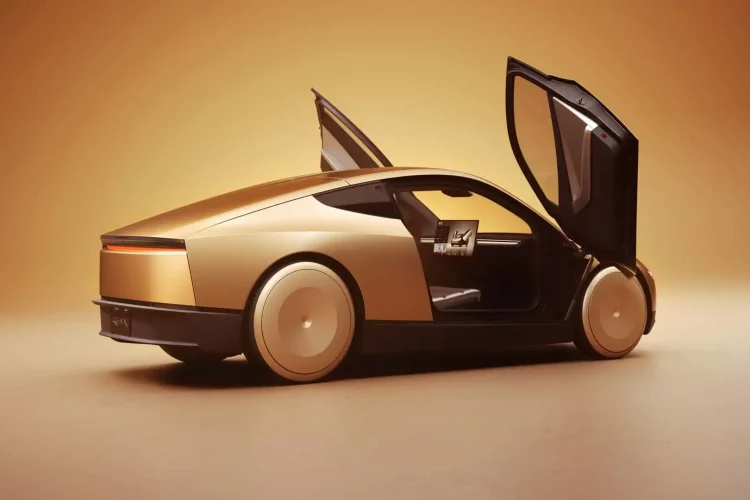
- By Retford TECH
- In Tech News
Tesla Cybercab: A New Era of Autonomous Robotaxis Unveiled by Elon Musk
Tesla has made significant strides in autonomous technology, and in October 2024, the company officially unveiled the highly anticipated Cybercab—Tesla’s vision for the future of autonomous transportation. At the “We, Robot” event, CEO Elon Musk introduced the public to a vehicle designed specifically for a driverless future. The Cybercab is a fully autonomous robotaxi, with no steering wheel or pedals, aimed at providing affordable, on-demand transportation.
Cybercab: Tesla’s Flagship Robotaxi
The Cybercab is poised to revolutionize the ride-hailing industry. With a sleek design inspired by Tesla’s Cybertruck, the robotaxi features two gull-wing doors and a spacious interior. Musk revealed that it will be priced below $30,000, making it more affordable than most current ride-hailing services once it becomes fully operational. Tesla aims to begin production of the Cybercab by 2026, with high-volume manufacturing expected shortly after.
Musk emphasized that the Cybercab would be part of Tesla’s broader push to eliminate human drivers from transportation. Using Tesla’s Full Self-Driving (FSD) technology, the robotaxi will operate entirely autonomously. “The autonomous future is here,” Musk proclaimed during the unveiling, underscoring the impact of FSD technology on making transportation cheaper, faster, and safer.
A Key to Affordable and Sustainable Transport
One of the most striking features of the robotaxi system is its potential to drastically lower transportation costs. Without the need for a human driver, Tesla estimates that the cost of using a robotaxi will be a fraction of today’s ride-hailing services, with customers paying far less for trips. Musk also emphasized that parking lots could be reclaimed as parks in a world dominated by autonomous vehicles, as these cars could constantly be in use, reducing the need for parking spaces.
This concept ties into Musk’s vision of an “individualized form of mass transit,” where passengers are transported directly to their destinations without the stops or delays associated with traditional public transportation systems. The efficiency of autonomous cars means they will be in use nearly 100% of the time, as opposed to personal cars, which are only used for a fraction of the day. This shift is expected to dramatically reduce the number of vehicles on the road while increasing their utility.
The Role of Full Self-Driving Technology
At the core of Tesla’s robotaxi program is the company’s Full Self-Driving (FSD) software. While Tesla’s existing cars already feature advanced driver assistance systems, the Cybercab will rely entirely on FSD technology. FSD, which uses a suite of cameras and neural networks to interpret the car’s surroundings, will allow the robotaxi to navigate complex urban environments, respond to traffic, and make decisions in real time without human intervention.
Musk has been optimistic about FSD’s potential, claiming that it will make cars “ten times safer” than those driven by humans. He pointed out that autonomous vehicles don’t get distracted, tired, or impaired, and can react more quickly than human drivers, making them inherently safer on the road.
However, regulatory approval remains a challenge. While Tesla expects to achieve fully unsupervised FSD in states like California and Texas by next year, the company must still navigate various regulatory hurdles. Safety concerns and the need for testing in diverse driving conditions have slowed the rollout of fully autonomous cars. Nonetheless, Tesla’s strategy of incrementally improving and deploying its technology gives it a competitive edge over other companies working on autonomous driving.
The Robovan: A High-Density Autonomous Transport
In addition to the Cybercab, Musk also introduced the Robovan, an autonomous transport vehicle designed to carry up to 20 passengers. Tesla envisions the Robovan being used for various purposes, from public transportation to commercial deliveries. Like the Cybercab, the Robovan will feature Tesla’s FSD technology, allowing it to operate without a human driver.
The Robovan adds a new dimension to Tesla’s vision of autonomous mobility. It’s designed to replace traditional buses and shuttles, offering a cleaner, more efficient mode of transportation that can be adapted for both personal and commercial use.
Tesla’s Vision for the Future of Mobility
Musk’s unveiling of the Cybercab and Robovan reflects Tesla’s ongoing commitment to making autonomous driving a mainstream reality. While the challenges of scaling robotaxi production and gaining regulatory approval remain, Tesla is betting big on the long-term benefits of fully autonomous vehicles. The company expects that its fleet of self-driving cars will reduce traffic accidents, cut transportation costs, and reshape urban landscapes by reducing the need for parking and personal vehicles.
As Musk noted, “With autonomy, you get your time back.” This fundamental shift in how we think about transportation could eventually lead to a future where cars are not just machines for commuting but integral parts of a broader, more efficient ecosystem of urban mobility.





